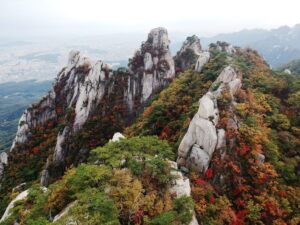With Halloween festivities in full swing here in Seoul, it’s hard not to
be in the spirit.
Jack-o-lantern cutouts plaster the windows of restaurants, costumes have been donned, and posters in the city’s nightlife districts advertise Halloween-themed dance parties. Vampires, zombies, and mad scientists wander the streets, snapping photos with other cleverly costumed folks. And while Halloween would not be complete without these classic characters, it would not be Korea without a few of their own mythological creatures mingling in the mix.
But who are these creatures, you ask? Read on for a who’s who guide to Korea’s most famous ghosts, goblins, and monsters.
 |
| Dokkaebi bear a striking resemblance to Western trolls. Photo Credit |
Dokkaebi (도깨비)
Appearance: Dokkaebi take many different forms but are most commonly depicted as demonic or goblin-like, with horns and distorted faces. Still others resemble humans while some can only be sensed as certain sounds, such as the trotting of horses’ hooves.
Favorite Hangout: Dokkaebi reside in sparsely populated areas, such as thick woods, graveyards, and abandoned houses.
Characteristics: These mischievous little tricksters are known for their pranks and are fond of games, particularly ssireum, a type of Korean wrestling. They often challenge passersby to these games for the right to pass. As the Robin Hoods of the Korean monster world, dokkaebi are known for stealing from the greedy and rewarding the worthy. Their invisibility hat and magic club help make their trickery more efficient.
Fun Fact: Although this creature is often seen in traditional folklore and was once believed to be a symbol of an ancient religion, these days the
dokkaebi is the mascot for the Red Devils, the fanclub of Korea’s national soccer team. Furthermore, the hit 2016 drama
Guardian: The Lonely and Great God is centered around the story of a contemporary dokkaebi, who is played by actor Gong Yoo.
 |
| A contemporary Korean goblin. |
Looking to learn how to read Korean? Download this free cheat sheet and start reading in just 90 minutes!
 |
| Beware the stare of the jeoseung saja, the Korean Grim Reaper. Photo |
Jeoseung Saja (저승사자)
Appearance: Korea’s version of the Grim Reaper is always seen dressed in a billowing black robe and a gat, a Joseon dynasty-era black hat. Pale skin and sunken eyes meet only the eyes of those that are close to death.
Favorite Hangout: Jeoseung Saja wander the areas where death is imminent: hospitals, villages plagued by sickness, or scenes of accidents.
Characteristics: Although they appear to be human, they are spirits under the command of King Yeomna, ruler of the underworld and judge of the spirits of the recently departed. Jeonseung Saja are dispatched where needed to collect and guide the spirits down Hwangcheon Road to the afterlife. It is impossible to escape Jeoseung Saja when one’s time comes, as he cannot be reasoned with or bribed.
Fun Fact: Korean superstition states that dreaming about
Jeoseung Saja is an omen of death.
Guardian: The Lonely and Great God also features this Korean folktale character who is played by the popular actor Lee Dong Wook.
 |
| The modern day jeoseung saja, or grim reaper, as portrayed by actor Lee Dong Wook in Guardian: The Lonely and Great God |
 |
| A virgin ghost clad in sobok gives a vengeful stare. Photo Credit |
Cheonyeo Gwishin (처녀귀신)
Appearance:
Cheonyeo gwishin, or “virgin ghosts,” are most often depicted wearing
sobok, a white
hanbok worn at death. Older traditions demanded that single women not wear their hair up, so these ghosts are always seen with their hair down, partially hanging in their faces.
Favorite Hangout: Korean virgin ghosts tend to wander around their living family and friends, in hopes they will arrange a “ghost wedding,” a paper marriage with another deceased member of the village.
Characteristics: In times past, a woman’s role in Confucian Korea was to serve her father, her husband, and her son. Still today, this role still partially remains. Because cheonyeo gwishin meet an untimely death before finding a husband, they are unable to fulfill their purpose in life and because of this unfinished business, are unable to leave the worldly realm. When they choose to haunt a village, they are usually bitter and attempt to create hardship among their former family members and neighbors.
Fun Fact: In the past, when villages have suspected the presence of vengeful
cheonyeo gwishin spirits, they have “erected” phallic sculptures to pacify the bitter ghosts.
Haesindang Park (Penis Park) in Samcheok is a perfect example of this.
 |
| A gumiho shows off its characteristic nine tails. Photo Credit |
Gumiho (구미호)
Appearance: The gumiho is a fox that has lived for 1,000 years and has thus been given the power of shape-shifting. More often than not, it usually presents itself as a beautiful woman, but with fox-like characteristics such as a pointy nose or nine tails.
Favorite Hangout: Gumiho are often spotted in graveyards, digging up the recently deceased to gorge on human flesh and organs.
Characteristics: Because of the gumiho‘s shape-shifting powers, it has the ability to seduce unsuspecting humans (usually men) in an effort to eat their livers or hearts. Although the gumiho was originally depicted in folklore as a kind but naive creature, it was later regarded as a feral, blood-thirsty monster to be feared by all humans. Gumiho that were able to abstain from eating humans for a period of 1,000 days were allowed to permanently change into human beings and lose their inherently evil traits altogether.
Fun Fact: The 2010 drama My Girlfriend is a Gumiho featuring Lee Seung-gi and Shin Min-ah sparked a great amount of international interest in this folktale character.
 |
| Bathtubs are common hangouts of mul gwishin, or water ghosts. Photo |
Mul gwishin (물귀신)
Appearance: Mul gwishin are water ghosts, forever soaking wet with deathly pale skin and unusually long arms.
Favorite Hangout: Lakes, rivers, oceans, bathtubs and abandoned water wells like the one in The Ring are the hangouts of these Korean ghosts.
Characteristics: It seems that many deaths in Korea in the past and even in recent times have involved drownings, either accidental, homicidal or suicidal. Mul gwishin are the souls of those who have passed this way. These ghosts are particularly popular in horror flicks and never seem to be fully exposed. Instead, their long, lanky arms tend to rise up from the water, attempting to pull unsuspecting swimmers under to join them in the cold murky depths as companions in the afterlife.
Fun Fact: America’s
Saturday Night Live used a Korean
mul gwishin as the main character in its sketch “
Aw Nuts! Mom’s a Ghost.”
What ghosts or goblins are unique to your country’s folktales or pop culture? Share your favorites in the comments box below.
Words by Mimsie Ladner of Seoul Searching. Photos credited to the source. Content may not be republished unless authorized.









